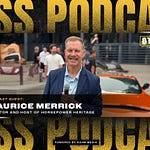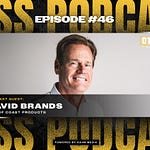BluePrint Engines CEO Norris Marshall on “Only The Strong Survive”
BluePrint Engines CEO Norris Marshall is an amazing example of a true American entrepreneurial success story. Born in rural Nebraska, Marshall spent much of his youth working on the farm. However, he began working in a small-town repair shop in his teenage years. It was there that he discovered his love of working on engines. Eventually, Marshall moved from fixing small lawnmower engines to larger ones when he began working at a local machine shop.
Marshall quickly left that machine shop to start his own, showing his entrepreneurial spirit. From those humble beginnings as a small machine shop, he guided his business to become one of America's premier builders of high-performance crate engines. With over 400,000 engines now produced, BluePrint Engines employs a vast array of engineers, engine builders, salespeople, support staff and other employees at its Kearney, Nebraska, headquarters.
The journey from a small machine shop to a leader in high-performance crate engines wasn’t easy or a straight path. In this episode of the “Only The Strong Survive” podcast, Marshall discusses what he learned from that experience with host Dan Kahn. Click on the play icon to watch this fascinating discussion that is a must for anyone running their own business. Here are our top five takeaways:
Always keep pivoting.
Company culture is more important than many people think.
Fantastic employees are the result of training and development.
Mentoring is a great way to develop your employees further.
Employee ownership is a way to ensure your team is vested in long-term success.
Don’t Be Afraid to Pivot
Key to BluePrint’s success is Marshall’s willingness to shift business models. Initially, he started the business as a small machine shop, but it was limited to supplying local engine builders. Wanting to grow the business further, Marshall shifted to building remanufactured replacement engines. That change led to massive growth, with BluePrint producing over 100 engines a day. However, as factory OEM engines improved, the need to replace them dwindled. Once again, Marshall shifted to building complete and brand-new high-performance engines to continue the company’s success.
“The amount of remanufactured engines that the world needed shrank in a very short period of time. It was kind of like Kodak film. Kodak had all the imaging going on, but in a 10-year period of time, it disappeared, and nobody needed film. So, we were back to needing to change what we do and being more viable,” says Marshall. “The good part is that was the beginning of BluePrint Engines. We had the equipment, knew about engines and knew how to make the engines.”
Company Culture is Just as Important as Your Products
Company culture is often overlooked in the drive to produce more products and create new ones. However, it is essential and should never be ignored. Recognizing this fact long before company culture became a more recent focus, Marshall carefully built the right one. The move proved wise, as Marshall built a brand that employees want to be a part of and move forward.
“I guess the culture comes from me, how I want to treat our employees and how I expect our managers to treat our employees. I start with the idea that everybody wants to do a good job, and you just have to find a way to let them,” says Marshall. “I also do believe that people are capable of a lot more than we realize if we challenge and encourage them. So, I am big on challenging and encouraging. I’ve got a lot of push, and I am not easy to work for. At the same time, I am on their side, and I want to help them. I think you need to make it personal, too. People need to know that you care about them, and when the moment arises to show that, you really need to show up.”
Grow Your Employees
In the daily grind of running a business, individual employees can be just as overlooked as company culture. However, if you want your company to succeed, you need to pay attention to both its culture and employee growth. Properly training employees and taking a vested interest in their development makes them better at their jobs and more impactful to a company as a whole.
“Great companies are made up of awesome people who are really just regular people who were given a chance to be great. Everybody’s got some of that greatness in them,” says Marshall. “I realized that when you are looking at your competitor and admiring their people if you can’t admire your people, you probably need to do more to try to develop and train them because it is in most of them to be really great at something.”
Mentoring Matters
Mentors are equally as crucial to employee development as proper training. The right mentors can guide employees, pass along knowledge and help teach valuable skills. A mentor from outside a company can also bring fresh perspectives and new ways of tackling issues or problems. With a mentor making a big difference in his early career, Marshall happily makes them available to his employees.
“We have a lot of people here on the leadership team who have been here for a long time. For the most part, they haven’t worked anywhere else. We need that outside influence (of a mentor), so they know more than what we collectively know at BluePrint,” says Marshall. “So let’s get them with somebody who can teach them those other things. For the most part, I see really, really fantastic growth and change in the individuals who get mentored.”
Boosting Buy In
Getting employees to buy in and believe in your organization's mission is critical. One way Marshall boosts buy-in at BluePrint is by having employees literally buy into the company. By offering employees the chance to purchase stock in the company that yields returns based on its performance, they become more vested in the long-term success of BluePrint. The stock isn’t free or cheap, ensuring a deeper level of commitment among the employees who purchase it. It also gives a path to BluePrint’s longevity beyond Marshall and keeps ownership within the company.
“I did enough research five years ago on who you can sell a business to and learned about strategic buyers and private equity, and I also learned about employee ownership. So, to create a path, and there is no guarantee this is how it is going to end, my wife and I decided to sell about 10 percent of the stock in the company. We ended up with a group of about a dozen employees who purchased stock. It is not phantom stock or an ESOP,” says Marshall. “One of the attributes about it that I really like is that the employees ultimately get wealthy. I think it is important to really have that carrot out there that if you come in here and buy stock and sweat it out, make those payments and continue to buy more stock when you can, by the time you’re 50 or 60 and if you have a high-level job, you’re going to own enough stock that you are going to be rich.”












